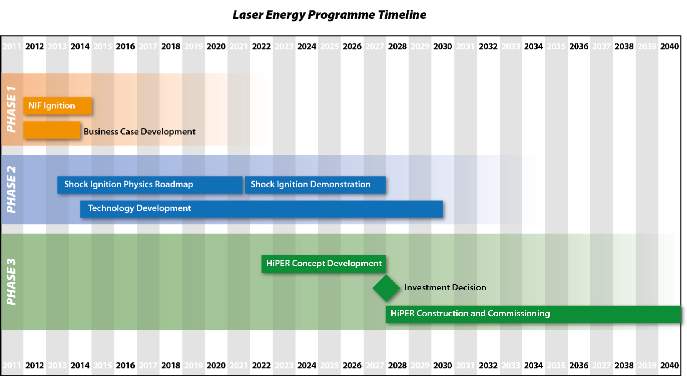 |
||||||||||||||||||||
 |
||||||||||||||||||||
 |
||||||||||||||||||||
In October 2006 the HiPER Project was accepted onto the roadmap of future research infrastructures for ESFRI, the European Strategy Forum on Research Infrastructures.
The Project has since progressed through Concept and into the Preparatory Phase, which runs until April 2013.
The Preparatory Phase defines the future phasing strategy and addresses financial, legal and governance issues, in parallel with technical risk reduction to enable the Project to progress.
The Phasing Strategy of the HiPER Project
Following completion of the Preparatory Phase, two major project phases have been identified for HiPER :-
- A programme of technology development in partnership with European industry and physics scheme validation on existing facilities, culminating in a full-scale ignition demonstration on Laser Mégajoule (LMJ).
- HiPER concept development, detailed design and construction.
Given the scale of this project, a preparation period will be required to complete a Business Case justifying the investment. During this time existing links will be developed and widened with industry, academia and potential investors.
1. Next Phase
Technology development and physics scheme validation on LMJ
This phase will consist of two main strands of work; Physics Scheme Validation and Technology Development.
Physics Scheme Validation
Prior to a decision to proceed with HiPER construction the ignition scheme must be experimentally validated at full scale on an existing facility such as Laser Mégajoule (LMJ) or NIF.
In December 2010 the HiPER Executive Board made the important decision that the preferred ignition scheme for HiPER will be Shock Ignition, although other options including Fast Ignition with either electrons or protons are not excluded.
Experiments and associated numerical modelling, prior to completion of LMJ in ~2016, will be conducted using existing intermediate scale facilities including PALS (Czech Republic), PeTAL (France), Vulcan and Orion (UK), and Omega (US).
Once the modelling and experimental validation are sufficiently mature, an ignition campaign will commence on LMJ. Gain optimisation experiments will follow, to underpin the commercial viability of Laser Energy.
Technology Development
Nationally funded programmes in areas of short term high commercial potential are anticipated during the period following ignition at NIF. This includes next generation laser development, advanced materials and fusion chamber development and science community building .
Activity is divided into three main areas :-
- Technologies to underpin commercial exploitation of Laser Energy. This includes prototyping of “next generation” laser architectures capable of operation at the repetition rate, peak power, average power and energy efficiency necessary for commercial viability of Laser Energy
- Low-cost techniques for mass production of fuel capsules
- Systems engineering concepts for the fusion chamber, capable of withstanding the environment of fusion reactions at high repetition rate. Concept designs will be required to underpin the Construction Phase Business Case. These will include materials development and testing for reactor elements, tritium fuel management and breeding schemes and energy extraction systems
2. Final Phase
Plant concept development; investment appraisal and 'first of type' construction
The objective of HiPER is to demonstrate the overall systems integration and operation of a Laser Energy plant in a “utilities environment” to underpin the reliability and availability of the entire process, proving that Laser Energy is economically viable.
Timeline for the proposed Laser Energy Programme
Click diagram to enlarge
![]()
